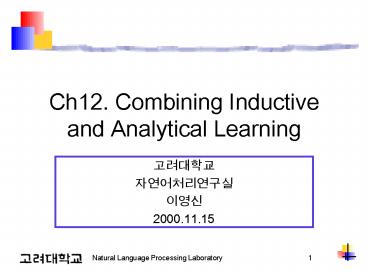Ch12. Combining Inductive and Analytical Learning PowerPoint PPT Presentation
1 / 18
Title: Ch12. Combining Inductive and Analytical Learning
1
Ch12. Combining Inductive and Analytical Learning
- ?????
- ????????
- ???
- 2000.11.15
2
Contents
- Motivation
- KBANN algorithm
- EBNN algorithm
- FOCL algorithm
3
Motivation (1/2)
- Inductive learning vs Analytical learning
Inductive learning
Analytical learning
Plentiful data No prior knowledge
Perfect prior knowledge Scarce data
4
Motivation (2/2)
- Goal
- Combine two mechanisms to obtain the benefits of
both approaches - Properties of combined method
- Given no domain theory, it should learn at least
as effectively as purely inductive methods - Given a perfect domain theory, it should learn at
least as effectively as purely analytical methods - Given an imperfect domain theory and imperfect
training data, it should combine the two to
outperform either purely inductive or purely
analytical methods - It should accommodate an unknown level of error
in the training data - It should accommodate an unknown level of error
in the domain theory
5
KBANN (1/6)
- KBANN(Knowledge-Based Artificial Neural Network)
algorithm - Given
- A set of training examples
- A domain theory consisting of nonrecursive,
propositional Horn clauses - Determine
- An artificial neural network that fits the
training examples, biased by the domain theory
6
KBANN (2/6)
- KBANN( Domain_Theory, Training_Examples )
- Analytical step Create an initial network
equivalent to the domain theory - For each instance attribute create a network
input - For each Horn clause in the Domain_Theory, create
a network unit as follows - Connect the inputs of this unit to the attributes
tested by the clause antecedents - For each non-negated antecedent of the clause,
assign a weight of W to the corresponding sigmoid
unit input - For each negated antecedent of the clause, assign
a weight of W to the corresponding sigmoid unit
input - Set the threshold weight w0 for this unit to
(n-0.5)W, where n is the number of non-negated
antecedents of the clause - Add additional connections among the network
units, connecting each network unit at depth i
from the input layer to all network units at
depth i 1. Assign random near-zero weights to
these additional connections - Inductive step Refine the initial network
- Apply the Backpropagation algorithm to adjust the
initial network weights to fit the
Training_Examples
7
KBANN (3/6)
- Example (the Cup learning task)
- Domain theory
- Cup ? Stable, Liftable, OpenVessel
- Stable ? BottomIsFlat
- Liftable ? Graspable, Light
- Graspable ? HasHandle
- OpenVessel ? HasConcavity, ConcavityPointsUp
- Training examples
8
KBANN (4/6)
- A neural network equivalent to the domain theory
9
KBANN (5/6)
- Result of inductively refining the initial network
10
KBANN (6/6)
- Hypothesis space search in KBANN
11
EBNN (1/6)
- TangentProp algorithm
12
EBNN (2/6)
- EBNN(Explanation-Based Neural Network) algorithm
- Given
- A set of training examples
- A domain theory represented by a set of
previously trained neural networks - Determine
- A new neural network that approximates the target
function f - This learned network is trained to fit both the
training examples and training derivatives of f
extracted from the domain theory
13
EBNN (3/6)
- EBNN algorithm
- Creates a new, fully connected feedforward
network to represent the target function - Initialized with small random weights
- For each training example ltxi,f(xi)gt
- Determines the corresponding training derivatives
in a two-step process - First, it uses the domain theory to predict the
value of the target function for instance xi
( A(xi) ) - Second, the weights and activations of the domain
theory networks are analyzed to extract the
derivatives of A(xi) with respect to each of the
components of xi - Using a minor variant of the TangentProp
algorithm to train the target network to fit the
following error function
14
EBNN (4/6)
xi ith training instance A(x) the domain
theory prediction for input x xj jth component
of the vector x The coefficient c is a
normalizing constant whose value is chosen to
assure that for all i, 0 µj 1
15
EBNN (5/6)
16
EBNN (6/6)
- Hypothesis space search in EBNN
17
FOCL (1/2)
- FOCL algorithm
18
FOCL (2/2)
- Recognizing legal chess endgame positions
- 30 positive, 30 negative examples
- FOIL 86
- FOCL ( (using domain theory with 76
accuracy) - NYNEX telephone network diagnosis
- 500 training examples
- FOIL 90
- FOCL 98 (using domain theory with 95 accuracy)

